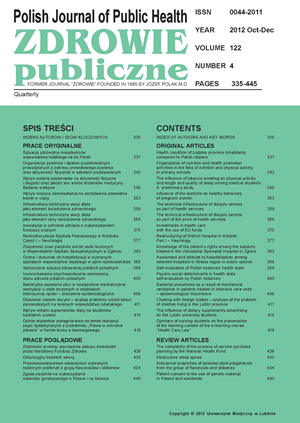Organization of nutrition and health promotion activities in the field of nutrition and physical activity in primary schools
DOI:
https://doi.org/10.12923/j.0044-2011/122-4/a.02Keywords:
organization of nutrition, health education, school canteens, ccs, educational programsAbstract
Introduction. The organization of nutrition and physical activity at school is an important element which influences the health of the student’s development and disposition to learn.
Aim. The study was to evaluate the organization of the nutrition and health promotion activities in the field of nutrition and physical activity carried out in primary schools.
Material and methods. The study was conducted in the school year 2010/2011 in 58 primary schools, urban and rural areas of five randomly selected regions. The evaluation was based on analysis of anonymous questionnaires among school principals regarding the organization of nutrition in schools, and programs / preventive actions related to the improvement of nutrition and physical activity among children and adolescents in these schools.
Results. About 40.8% of students eat meals at school among the schools offering school lunches, including 38.5% in urban schools and slightly more – 42.4% in rural schools. Most schools (87.7%) are carrying out programs / activities related to the improvement of nutrition and physical activity, including 93.5% of urban schools and 80.8% of rural schools. Among the directors of schools in which there are shops, 80.5% declared that the school introduced some restrictions but in small range. It was found that in 42.9% of schools there are food and beverage advertisements. Participation in the extra-curricular sports activities organized by these school is declared by 36.6% of the students.
Conclusions. In Poland the problem of nutrition in schools is not yet adequately resolved for many reasons, including organizational and financial ones. However, the increasing involvement of schools in educational activities related to the improvement of nutrition and physical activity among children and adolescents by conducting numerous activities and health promotion programs was found.
References
1. Howerton MW, Bell BS, Dodd KW, et al. School-based nutrition programs produced a moderate increase in fruit and vegetable consumption: meta and pooling analyses from 7 studies. J Nutr Educ Behav. 2007; 39:186-96.
2. Matvienko O. Impact of a nutrition education curriculum on snack choices of children ages six and seven years. J Nutr Educ Behav. 2007; 39:281-5.
3. Carter R. The impact of public schools on childhood obesity. J Am Med Assoc. 2002;288(17):2180.
4. Kleinman R, Halls S, Green H et al. Diet, breakfast and academic performance in children. An Nutr Metab. 2002;46(suppl.1):24-30.
5. Woynarowska B, Mazur J, Kowalewska A. Organizacja żywienia uczniów w szkole a profilaktyka nadwagi i otyłości. Zdr Publ. 2008;118(2):132-7.
6. Woynarowska B, Małkowska-Szkutnik A, Mazur J. School meals policy on promoting healthy eating in schools in Poland. Med Wieku Rozw. 2011;15(3):232-9.
7. Czeczelewski J. Częstotliwość spożywania pierwszych i drugich śniadań przez uczniów klas IV-VI na przykładzie szkół podstawowych miasta Biała Podlaska. Rocznik PZH. 2001;52:321-8.
8. Centrum Komunikacji Społecznej Urzędu m.st. Warszawa. Organizacja żywienia w warszawskich szkołach podstawowych – raport 2009. www.um.warszawa.pl/wiemcojem/
9. Wajszczyk B, Charzewska J, Rogalska-Niedźwiedź M, et al. Zwyczaje żywieniowe młodzieży związane z częstotliwością spożywania posiłków a nadwaga i otyłość. Zdr Publ. 2006;116:491-3.
10. Sygit K. Nieprawidłowości żywieniowe zagrożeniem zdrowia populacji dzieci i młodzieży. Zdr Publ. 2010;120(2):132-5.
11. Chlebna-Sokół D, Zbęk E, Sobczak M. Zachowania zdrowotne dzieci, młodzieży i wybranych grup młodych dorosłych w Polsce – przegląd piśmiennictwa. Zdr Publ. 2007;117(1):63-7.
12. Szatko F, Wierzbicka M, Grzybowski A. Kariogenne wzorce żywieniowe polskich dzieci narzucone przez sklepiki szkolne. Prz Stomatol Wieku Rozw. 2001;3/4:80-6.
13. Ludwig DS, Peterson KE, Gortmaker SL. Relation between consumption of sugar-sweetened drinks and childhood obesity: a prospective observational analysis. Lancet. 2001;357:505-8.
14. Wolnicka K, Jaczewska-Schuetz J. Zachowania żywieniowe dziewcząt i chłopców klas V-VI szkół podstawowych z losowo wybranych szkół warszawskich. Żyw Człow Metab. 2010;4:255-67.
15. Agencja Rynku Rolnego. Program „Owoce w szkole”, Program „Szklanka mleka”. www.arr.gov.pl
16. Patric H, Nicklas TA. A review of family and social determinants of childrens eating patterns and diet quality. J Am Coll Nutr. 2005;24:83-92.
17. Charzewska J, Chabros E. Rola aktywności fizycznej i jej wpływ na prawidłowy rozwój fizyczny i stan zdrowia. Ile powinna wynosić optymalna aktywność ruchowa ucznia dziennie i dlaczego? In: Jarosz M, (ed). Zasady prawidłowego żywienia dzieci i młodzieży. Warszawa: IŻŻ; 2008. p.189-201.
18. Hastings G, Stead M, McDermott L et.al. Review of research on the effects of food promotion to children. Final Report prepared for the Food Standards Agency. University of Stratchlyde; 2003.


